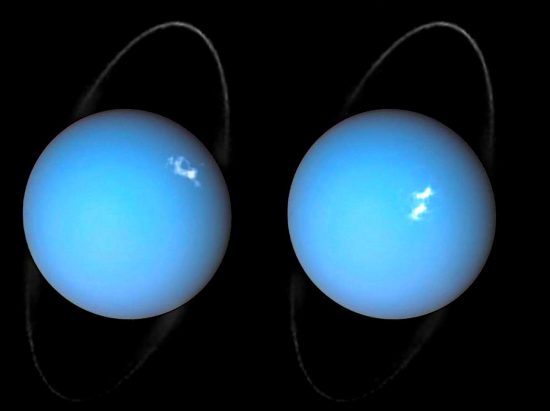
September 29, 2020
Uranus is an anomaly in the Solar System.
The gas giant planet, Uranus is 50,724 kilometers in diameter at the equator, making it the third largest object in the Solar System. A unique aspect of Uranus is that its equator is tilted almost 90 degrees. Most of the other planets are tilted no more than 24 degrees past vertical. Uranus takes 84.3 Earth years to revolve around the Sun, so it has not been extensively investigated. The Keck telescope in Hawaii came on-line in November 1990 and its first use of adaptive optics was on October 2003. Before that, detailed observations from Earth were impossible because of atmospheric distortion.
According to a recent press release, the rings of Uranus are “surprisingly bright” in images provided by two telescopes in Chile. Astronomer, Imke de Pater from UC Berkeley wrote:
“Saturn’s mainly icy rings are broad, bright and have a range of particle sizes, from micron-sized dust in the innermost D ring, to tens of meters in size in the main rings. The small end is missing in the main rings of Uranus; the brightest ring, epsilon, is composed of golf ball-sized and larger rocks.”
The “thermal emission” spectra are evidence of heat from its rings, but the environment near Uranus is actually a mind-numbing -196 Celsius. The epsilon ring is not like other ring systems in the Solar System. Jupiter and Neptune also exhibit rings, but epsilon differs in composition from them. As the announcement states, Jupiter’s rings contain mostly small, micron-sized particles, while the rings of Saturn and Neptune are mostly dust, with some larger objects distributed in Saturn’s outer rings.
Graduate student Edward Molter said:
“We already know that the epsilon ring is a bit weird, because we don’t see the smaller stuff. Something has been sweeping the smaller stuff out, or it’s all glomming together. We just don’t know…”
A previous Picture of the Day reported that the Hubble Space Telescope began to observe Uranus in 1998, so there has not been time to observe even one year’s seasonal changes. It was the Hubble telescope that discovered aurorae on Uranus, another surprise to planetary scientists. Since the magnetic field on Uranus is inclined by 59 degrees from its spin axis, aurorae are not near the planet’s poles.
Uranus is subject to gigantic storms that seem to appear from nowhere. Like the other gas giants, Uranus radiates more energy than it receives from the Sun. Saturn, for instance, radiates 2.3 times more infrared than reflection of solar radiation off its cloud tops can explain, while Uranus emits 1.1 times more radiant energy, the majority in infrared.
It is most likely that the anomalous winds, storms, the aurorae, and the faint ring system on Uranus are caused by processes that Electric Universe advocates see throughout the cosmos.
For example, Saturn experiences a “mysterious dragon storm” that erupts from below the clouds. Jupiter’s Great Red Spot is hotter than its surroundings and has been spinning through its atmosphere for more than 300 years. In each case, the power needed to drive those phenomena comes from electricity.
Like Saturn and Jupiter, Uranus is a miniature solar system, with a family of 27 moons. Its Langmuir charge sheath, or plasmasphere, isolates it from the Sun’s own charge sheath.
That electric charge differential also sorts particles depending of their composition and conductivity. Just as the Sun holds its planets in alignment via electromagnetism, the gas giants hold their rings and moons in electromagnetic force fields.
Uranus is a highly charged object, so it is possible that one or more of its moons are connected to it in the same way that Io is connected to Jupiter. Those connections strengthen when the solar wind adds more charge density to the giant planet, causing “hot spots” and aurorae. As time goes on, with more detailed and more prolonged observations, those questions ought to confirm the Electric Universe model of the Solar System.
Stephen Smith
The Thunderbolts Picture of the Day is generously supported by the Mainwaring Archive Foundation.












